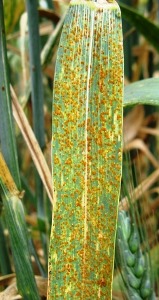Detailed Information: Leaf Rust
Compared to stripe and stem rust, leaf rust is potentially the least damaging in susceptible varieties, but in most seasons, conditions are conducive for this disease to develop. In Victoria, severe leaf rust infections can reduce grain yield by more than 20% in susceptible varieties and can also reduce grain quality.

Leaf rust is effectively controlled when resistant varieties are grown, but in cases where susceptible varieties are grown, fungicide protection may be required. Recent detections of new pathotypes of leaf rust means that many important cultivars have poor levels of resistance.
Symptoms: Orange-brown pustules on the upper surface of leaves, easily rubbed off, leaving a mark. Later in the season, black teliospores may appear, but they are not of concern.
Management: Grow resistant varieties, apply foliar fungicides early if necessary, and monitor fields during conditions favorable to the disease.
Disease Cycle: Leaf rust is caused by the fungus Puccinia triticina and is favored by wet conditions and temperatures between 15-22°C. Rust spores are wind-blown and spread easily, especially after wet summers.
Disease Expert Contact:
Dr Grant Hollaway
Dr Mark McLean
Cereal Pathologists – Horsham
03 5450 8301
Field Crops Pathology
Grains Innovation Park
110 Natimuk Rd, Horsham 3400
03 5450 8301
Or call the Customer Service Centre: 136 186





